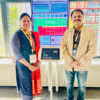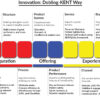
One of the more insightful lines ever written in modern management literature belongs to Jim Collins’ Good to Great:
“Good is the enemy of great. And that is one of the key reasons why we have so little that becomes great.”
The premise is extraordinarily simple, yet profound. Most institutions, societies, and entities do not become truly excellent not because they just happen to be terrible—but because they’re “good enough.” Comfort gives way to complacency, and complacency is the subtle annihilator of potential.
The Comfortable Trap of Good
A “good” life is stable, predictable, and respectable. A “good” life is decent income, modest reputation, and decent relationships. The issue is that good stifles the urge for boundaries.
Why try for greatness if good is satisfactory?
Indian philosophy cautioned against just such a comfort trap centuries ago. The Bhagavad Gita reminds us:
“You have a right to your action but not to its fruits. Never let the fruits of action become the motive.”
Greatness, in short, isn’t remaining at the plateau of ease but working hard, again and again, regardless of short-term compensation.
The Ekalavya legend: Converting good into great by diligent practice
Look at the case of Ekalavya from the Mahabharata. Although not permitted proper instruction by Dronacharya, Ekalavya’s dedication made him fashion a clay image of his potential guru and drill incessantly in front of it. His expertise in the bow became the stuff of legend and surpassed many of those who were given systematic instruction.
Ekalavya didn’t settle on “good.” He aimed for greatness by concentrating on discipline, faith in oneself, and hard work. His tale teaches us that achieving greatness usually means overcoming challenges that tempt us to “settle.”
International Insight: Steve Jobs and the “Insanely Great”
The founder of Apple, Steve Jobs, was famously obsessed with excellence. “Good” products didn’t do well. Products had to be “insanely great.” Jobs himself explained:
“Be a yardstick of quality. Some people aren’t used to an environment where excellence is expected.”
The iPhone, the Mac, the iPod—none of these products would have emerged if Apple was content to be a “good computer company.” Jobs’ intolerance for anything less than the best transformed the future of worldwide technology.
The Parable of the Archer
A Zen fable relates that a master marksman hit the bullseye without effort. His apprentice, awe struck, inquired how he hit the center. The master said, “The target is not ever the issue. The issue is my mind accepting ‘close enough.’ Excellence is accomplished not just by the arrow of desire hitting the target but by the arrow of desire breaching the boundaries of the self.”
This is a story that teaches us a universal fact: greatness is not a happenstance; it’s a result of not settling.
Example from India: A.P.J. Abdul Kalam
India’s “Missile Man,” and its erstwhile President, A.P.J. Abdul Kalam personified excellence by vision and determination. Having emerged from humble beginnings at Rameswaram, he could have lived a “good” life as a highly respected scientist. Yet, his aspiration to make India self-sufficient in defence technology made him a national aspiration icon. As he proclaimed:
“Dream, dream, dream. Thought takes shape and thought makes action.”
Greatness, Kalam taught us, is made by having the courage to dream beyond the confines of good.
When Organizations Settle
Jim Collins’ caveat is not merely for individuals but for institutions as well. The vast majority of schools are “good” enough to get students by on test-taking but few aspire to create innovators and leaders. Governments “good” enough to maintain stability fall short at becoming genuinely transformative.
In India, the ISRO and IITs are institutions which didn’t settle. The ISRO, with limited resources, would have been content to stay a “good” space research organization. However, its urge for excellence made India the first nation to land on Mars on its maiden attempt, and at a mere percentage of international expenditure.
The Cost of Settling
Internationally, consider Kodak. A great and reliable maker of cameras, it rested on its laurels and failed to reinvent itself for the digital revolution. In contrast, Amazon and Tesla opted for excellence by reinvention and fundamental innovation.
Greatness is difficult. It requires risk, resilience, and relentless self-study. Yet the cost of acceptably “good” is considerably higher—irrelevance, stagnation, and potential waste.
From Good to Great in Daily Life
Greatness isn’t necessarily creating empires or revolutionizing countries. At times it finds its place in ordinary life:
A doctor who will not just treat symptoms but work for overall healing of a patient.
A teacher who generates curiosity, not rote memorization.
A parent who teaches children not merely to succeed, but to serve and to elevate.
As Gandhi said:
“The best way to find yourself is to lose yourself in the service of others.”
Greatness is in choosing to rise above self-interest, beyond “good enough.”
Pragmatic Ways to Escape the “Good” Trap
Cultivate discomfort – Step beyond the comfort zone regularly. Growth thrives in discomfort.
Find excellence in small tasks – “Arise, awake, and stop not till the goal is reached,” Swami Vivekananda instructed. Greatness is realized by daily excellence.
Surround yourself with challengers – People who challenge you upwards won’t allow you to stagnate.
Keep a learning mindset – Never assume you’ve “arrived.” Becoming great is a journey.
Final thoughts
“Good is the enemy of great.” Such lines are not a business model by themselves—they are a way of life. From Ekalavya to Steve Jobs, from Abdul Kalam to Zen masters, greatness boils down to people and institutions not tolerating mediocrity. The world does not remember those who were merely good. The world remembers those who were great—those who pushed, remained, and worked for greatness continuously. The choice is ours. Shall we accept “good enough”? Or shall we have the boldness, as Collins challenges us, to compete for greatness?
Dr. Prahlada N.B
MBBS (JJMMC), MS (PGIMER, Chandigarh).
MBA in Healthcare & Hospital Management (BITS, Pilani),
Postgraduate Certificate in Technology Leadership and Innovation (MIT, USA)
Executive Programme in Strategic Management (IIM, Lucknow)
Senior Management Programme in Healthcare Management (IIM, Kozhikode)
Advanced Certificate in AI for Digital Health and Imaging Program (IISc, Bengaluru).
Senior Professor and former Head,
Department of ENT-Head & Neck Surgery, Skull Base Surgery, Cochlear Implant Surgery.
Basaveshwara Medical College & Hospital, Chitradurga, Karnataka, India.
My Vision: I don’t want to be a genius. I want to be a person with a bundle of experience.
My Mission: Help others achieve their life’s objectives in my presence or absence!
My Values: Creating value for others.
Leave a reply
















Dear Dr. Prahlada N.B Sir,
Your thought-provoking blog post, "Good is the Enemy of Great: Why Settling is the Silent Killer of Potential," resonates deeply. The concept that "good" can often hinder us from achieving greatness is both profound and timely. Your examples, ranging from Ekalavya's dedication to Steve Jobs' relentless pursuit of innovation, beautifully illustrate the importance of striving for excellence.
Thank you for sharing your wisdom and experiences. Your blog post is a compelling reminder that greatness is within our reach if we're willing to push beyond the boundaries of "good enough."
Reply